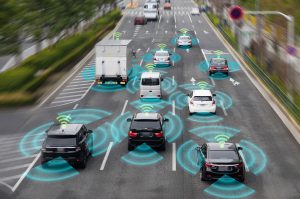
Not so long ago, a “collision warning system” was defined as nothing more than “honking your horn.” While that analogue system still has its place, it is limited in its preventive measures, not to mention its potential for misuse. Fortunately, advancements in ADAS technology (Advanced Driver Assistance Systems) have greatly expanded our collision warning measures, but the industry has also been hard at work taking that technology a step further by enabling our cars to alert us—and each other—to real-time, dynamic information. Vehicle-to-vehicle (V2V) communications systems are composed of devices that use dedicated short-range radio communication (DSRC) to communicate messages with each other.1 V2V enables vehicles to wirelessly exchange information about their speed, position and direction of travel.2
Watch how V2V technology provides drivers with a warning of a potential crash through 360-degree awareness of similarly equipped vehicles within communication range.2
Because connected vehicles provide drivers with tools to anticipate and potentially avoid collisions, NHTSA research shows that V2V technology could prevent up to 600,000 crashes and save up to 1,080 lives each year.1 Despite these anticipated advantages, there are also several areas of concern surrounding the widespread deployment of vehicle-to-vehicle communication.
Liability, Privacy and Safety Questions
For this new technology to be successful and widely adopted, automobile manufacturers, government regulators and the insurance and collision repair industries must work together to answer these three questions.
What effect will this have on liability?
As cars become increasingly autonomous, questions arise about who is responsible in the event of a crash. As explained in the NHTSA V2V Readiness Report, “OEMs have expressed concern that “V2V technologies will increase their liability as compared with other safety technologies. In their view, a V2V system exposes them to more legal risk than onboard safety systems because V2V warning technologies rely on information received from other vehicles via communication systems that they themselves do not control.”3
Will customer privacy be protected?
Consumers are skeptical about how their data will be used and whether V2V systems can be exploited by hackers. However, NHTSA has proposed a central strategy around data anonymization along with specific design requirements for manufacturers to help prevent cyberattacks.4
How should the collision repair industry prepare?
Repairer Driven News warns that collision repairs and aftermarket installers of V2V shouldn’t take this process lightly.5 Incorrect calibration “could compromise the important safety feature and jeopardize more vehicles besides a customer’s car.”5
V2V Technology Outpaces Regulation
The Department of Transportation and the NHTSA have been researching crash avoidance technology for more than a decade. In 2016, a proposed rulemaking notice was issued to require V2V communication technology in all new cars by 2023.3 However, to date, there is still no final decision to move forward with the proposed rule.7 Suppliers and automakers have been moving forward, putting this safety technology in cars, even as regulators are slow to act.8 The next generation of Cadillac, Toyota, Audi and Mercedes models may soon be “talking” to each other as well as avoiding each other.9
Paving the Way to Driverless Cars
V2V technology is just one element of vehicle-to-everything (V2X) communication thought to be critical to making automated driving possible. As Toyota states, “These vehicle-to-vehicle, and vehicle-to-infrastructure, and vehicle-to-pedestrian communications share information about road signals, signs, road conditions, and other vehicles or pedestrians that may be difficult to see.”10
With this new wave of connectivity comes unprecedented challenges as well as opportunities, especially as it relates to the data generated by today’s modern vehicles. Read more about connected car data and its role as Your Vehicle’s True Emissions.
1https://www.nhtsa.gov/sites/nhtsa.dot.gov/files/documents/v2v_fact_sheet_101414_v2a.pdf
2https://www.nhtsa.gov/technology-innovation/vehicle-vehicle-communication
3https://www.nhtsa.gov/staticfiles/rulemaking/pdf/V2V/Readiness-of-V2V-Technology-for-Application-812014.pdf
4 https://us.eversheds-sutherland.com/portalresource/lookup/poid/Z1tOl9NPluKPtDNIqLMRV56Pab6TfzcRXncKbDtRr9tObDdEoS3CnO3!/fileUpload.name=/Addressing%20V2V%20Data%20Privacy%20Concerns%20In%20New%20NHTSA%20Rules.pdf
5https://www.repairerdrivennews.com/2016/12/19/nhtsa-describes-possible-v2v-calibration-considerations-role-for-aftermarket-production-installation-in-older-cars/
6https://www.claimsjournal.com/news/national/2016/12/15/275616.htm
7https://www.nhtsa.gov/press-releases/v2v-statement
8https://www.consumerreports.org/automotive-technology/toyota-v2v-vehicle-to-vehicle-communications/
9https://www.zdnet.com/article/the-x-factor-in-our-driverless-future-v2v-and-v2i/
10https://automatedtoyota.com/elements-of-automated-driving/
This article is care of https://www.mpower.mitchell.com/vehicle-vehicle-communications-may-mean-auto-insurers-collision-repair-facilities/?utm_source=Eloqua&utm_medium=email&utm_campaign=mpower_email_0320_APD_INS

